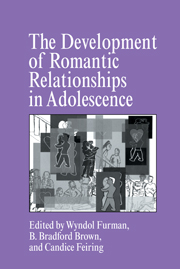Book contents
- Frontmatter
- Contents
- Contributors
- Foreword
- Acknowledgments
- 1 Missing the Love Boat: Why Researchers Have Shied Away from Adolescent Romance
- Part I Processes in Romantic Relationships
- 2 The Emotions of Romantic Relationships: Do They Wreak Havoc on Adolescents?
- 3 The Nature and Functions of Social Exchange in Adolescent Romantic Relationships
- 4 Cognitive Representations of Adolescent Romantic Relationships
- 5 Romantic and Sexual Relationship Development During Adolescence
- Part II Individual Differences in Romantic Relationships
- Part III The Social Context of Romantic Relationships
- Part IV Conclusion
- Author Index
- Subject Index
4 - Cognitive Representations of Adolescent Romantic Relationships
Published online by Cambridge University Press: 05 October 2014
- Frontmatter
- Contents
- Contributors
- Foreword
- Acknowledgments
- 1 Missing the Love Boat: Why Researchers Have Shied Away from Adolescent Romance
- Part I Processes in Romantic Relationships
- 2 The Emotions of Romantic Relationships: Do They Wreak Havoc on Adolescents?
- 3 The Nature and Functions of Social Exchange in Adolescent Romantic Relationships
- 4 Cognitive Representations of Adolescent Romantic Relationships
- 5 Romantic and Sexual Relationship Development During Adolescence
- Part II Individual Differences in Romantic Relationships
- Part III The Social Context of Romantic Relationships
- Part IV Conclusion
- Author Index
- Subject Index
Summary
Romantic relationships are a new and exciting arena for adolescents. As they embark on these relationships, they try out unfamiliar behaviors, experiment with different ways of interacting, and acquire new skills. They have to make sense out of many novel, often surprising experiences. Much time is devoted to thinking or talking about their boyfriend or girlfriend and their relationship. They may wonder what a particular interaction meant or how each feels about the other. Sometimes they mentally enact different hypothetical scenarios with romantic partners, using past relationship experiences to anticipate their own and their partner's response to a given situation.
These thoughts, beliefs, and expectations concerning romantic relationships vary from person to person. For example, when faced with a family problem, one adolescent may think that she should turn to her partner to seek comfort and guidance. Another may feel that she should keep the problem to herself, fearing that the other would consider the problem to be insignificant and would not be interested. A third may feel it is important to seek out her partner, yet may think she is likely to be dissatisfied with the other's effort to comfort her. Such thoughts or representations of relationships are expected to guide an individual's behavior and serve as a basis for predicting and interpreting others' behavior.
- Type
- Chapter
- Information
- The Development of Romantic Relationships in Adolescence , pp. 75 - 98Publisher: Cambridge University PressPrint publication year: 1999
- 71
- Cited by

